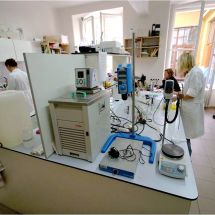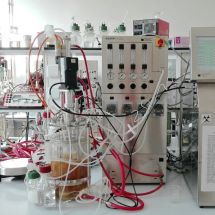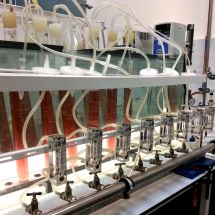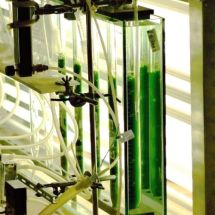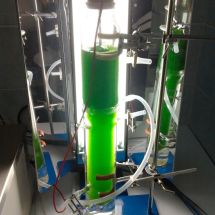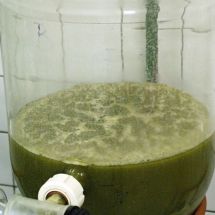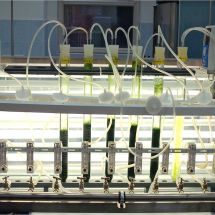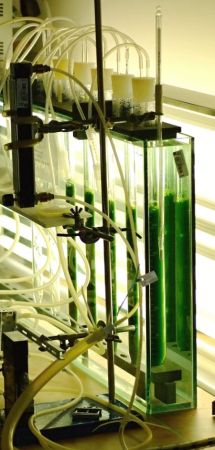
Our laboratory engages with engineering and biological aspects of biotechnologies, especially in the area of processes optimization (e.g. media composition, culture conditions) and mathematical modeling of bioprocesses. The main research topics include:
- Harnessing the biosorption potential of phototrophic microorganisms (study of mechanism and quantification of sorption of organic molecules)
- Biotechnology of marine organisms (cultivation processes, utilization of waste water)
- Study of the mechanism of adhesion of microbial contaminants of food to solid substrates
- Biotechnology of microalgae (culture techniques, utilization of waste water, new methods of harvesting algae, adhesion of algae to surfaces)
Research group members
- Prof. Tomáš Brányik, PhD
- Lucie Kyselová, PhD (on maternity leave)
- Tomáš Humhal, MSc (doctoral student)
- Jan Strejc, MSc (doctoral student)
- Zuzana Ježková, MSc (doctoral student)
- Anna Čadková, MSc (doctoral student)
- Tomáš Potočár, MSc (doctoral student)
- Undergraduate students
Main research topics
Biosorption potential of phototrophic microorganisms
Microalgal cell surfaces display a variety of binding sites, which allow biosorption of biologically active compounds. However, little is known about biosorption potential of phototrophic microorganisms towards organic molecules. The project aims to clarify fundamental relationships between adsorbent composition (microalgae and its fractions) and chemical structure of adsorbate. The scope of experimental work is defined by phototrophic taxons (Chlorella, Porphyridium, Arthrospira) and series of target compounds (polyphenols) with varying structures. Data on biosorption of individual polyphenols and their mixtures will be supported by physicochemical and chemical characterization of interacting entities, rheological data on dispersed systems and mathematical description of reaction equilibrium and kinetics. Based on this information, experiments will be performed to test 1) biosorption of ecologically, nutritionally, therapeutically relevant compounds of microalgal biomass or its fractions, 2) effective separation methods of dispersed sorbents from solutions, and 3) scale-up approaches.
Bioactive compounds from marine microorganisms
Marine unicellular microorganisms are very rich in bioactive compounds and thus may be used in several biological applications. The most studied substances are polyunsaturated fatty acids (PUFAs), sterols, proteins and enzymes, and vitamins and pigments, which find applications in areas such as human and animal nutrition, therapeutics, and aquaculture. This project will focus mainly on marine microorganisms (e.g. algae, cyanobacteria, bacteria), their cultivation and culture condition-induced changes in the composition of biomass, and the identification of bioactive compounds with biotechnological potential.
Anaerobic food spoiling bacteria and their biofilm forming potential
The project is aimed at isolation and identification of anaerobic bacteria in real biofilms from the food industry and in experimental research of factors (nutritive, culturing, stimulating and inhibiting) influencing the adhesion of selected anaerobic food-spoiling species to solid surfaces. The project is based on comparison between adhesion intensities of experimental data and growth rates of anaerobic bacteria adhered to solid materials (glass, plastics, steel etc.), with predictions of adhesion made according to mathematical models (X/DLVO theory, balance of interfacial free energies) using the physicochemical properties of interacting surfaces as inputs. The results will help to clarify the role of anaerobes in biofilm formation, in industrial practice to decrease the risks of biofilm formation by modifying the environmental conditions and surface properties of solids, and in processes of surface cleaning and sanitation.
Surface interactions of miroalgae
This project will carry out experimental research of factors (nutritive, growth conditions) influencing adhesion of industrially promising microalgae (food, environmental processes) to solid surfaces. The project is based on comparison of experimental data on adhesion intensities of microalgae, grown under different conditions to solid materials (glass, plastics, steel etc.), with predictions of adhesion made according to mathematical models (DLVO theory, balance of interfacial free energies) using physicochemical properties of interacting surfaces. The results are applicable both in cases when suppression of algal adhesion is desired (inner wall of photobioreactors) and in processes (biodegradation, biotransformation) where algal biofilm formation (immobilization) is wanted.
Collaboration
- University of Minho, Braga, Portugal
- KU Leuven, Belgium
- Escola de Engenharia de Lorena da Universidade de São Paulo, Brazil
- The Institute of Chemical Process Fundamentals of the ASCR, v. v. i., Czech Republic
- Institute of Microbiology of the ASCR, v. v. i., Czech Republic
- EcoFuel Laboratories, Czech Republic
- Research Institute of Brewing and Malting Inc., Czech Republic
- BOHEMIACHLAD Ltd., Czech republic

